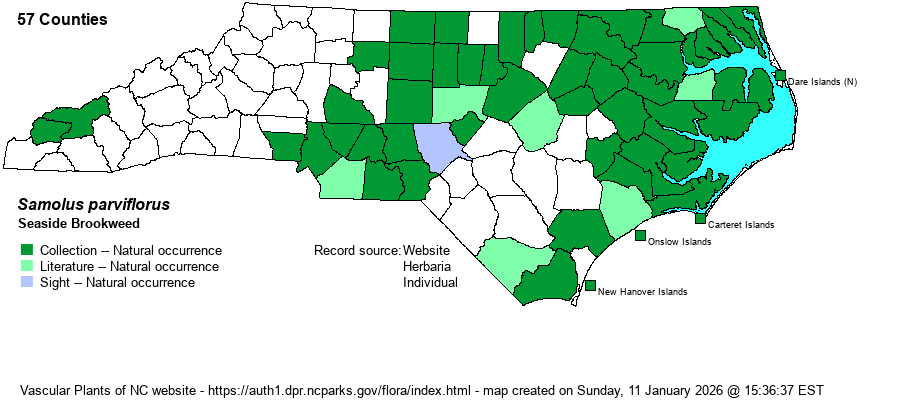| Author | Rafinesque | |
| Distribution | An odd range, occurring over most of the northeastern Coastal Plain, and most of the eastern half of the Piedmont. Yet, it is "missing" from most of the southwestern Coastal Plain, including the Sandhills region. Also, other than two Mountain county records (Graham and Swain), it seems to be absent from the western Piedmont (west of Forsyth and Gaston counties) and nearly all of the Mountains.
This is a widespread species, ranging from eastern Canada south to southern FL and southern TX. | |
| Abundance | Fairly common to frequent in the northeastern half of the Coastal Plain, south to Carteret and Jones counties, but rare farther south near the coast; nearly absent elsewhere in the province. Infrequent in the eastern half of the Piedmont, and extremely rare in the southwestern Mountains. | |
| Habitat | This is a wetland species that literally "likes it toes and feet wet". It grows along wooded streamsides or even in the creeks if very shallow, in shaded pools, various pond margins, marsh edges, and other mostly shaded to partly shaded wetlands. |
| Phenology | Blooms from April to October, and fruits within this large period. | |
| Identification | This species has characteristically shiny or glossy-looking, thick/fleshy leaves. It has numerous basal leaves, along with a leafy stem that grows to about 9-12 inches tall. The basal leaves are oblanceolate with rounded tips and tapered bases, mostly about 2-3 inches long and 3/4-inch wide. The branched and often zigzag stem has a few alternate leaves, each also oblanceolate and slightly smaller, again with rounded tips. From upper leaf axils grow a handful of racemes of small white flowers, many on each raceme. Each flower, with 5 petals, is only about 1/8-inch across. If you are working in swampy or shaded damp ground, and see clumps of basal leaves, quite shiny and fleshy, with rounded tips and leaves wider above the middle, you may well have this species. The inflorescences are actually quite "wispy" at any distance, and you will need to bend down to study or photograph the tiny white flowers. | |
| Taxonomic Comments | Though it has always been in Samolus, some references, even today, list it as S. valerandi ssp. parviflorus. S. valerandi is a European taxon, and thus some botanists consider our plants in North America only as a subspecies. Most, however, do give it species status, as S. parviflorus.
| |
| Other Common Name(s) | Water-pimpernel, Brookweed, Thinleaf Brookweed | |
| State Rank | S4 | |
| Global Rank | G5 | |
| State Status | | |
| US Status | | |
| USACE-agcp | OBL link |
| USACE-emp | OBL link |

